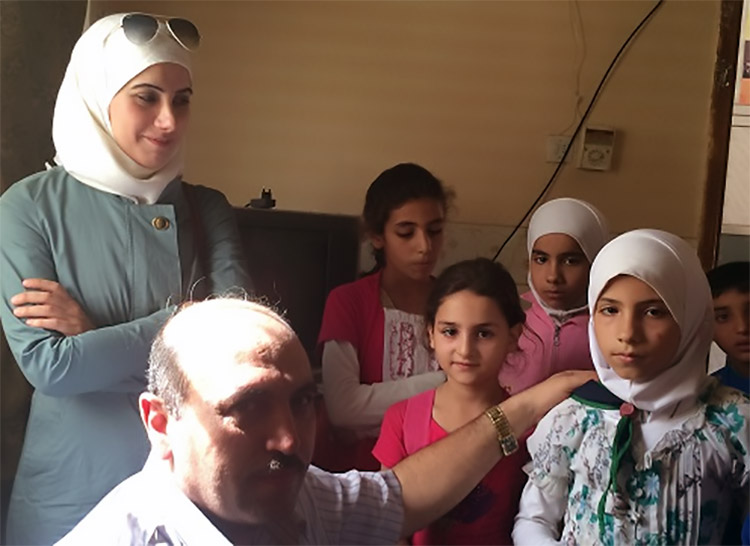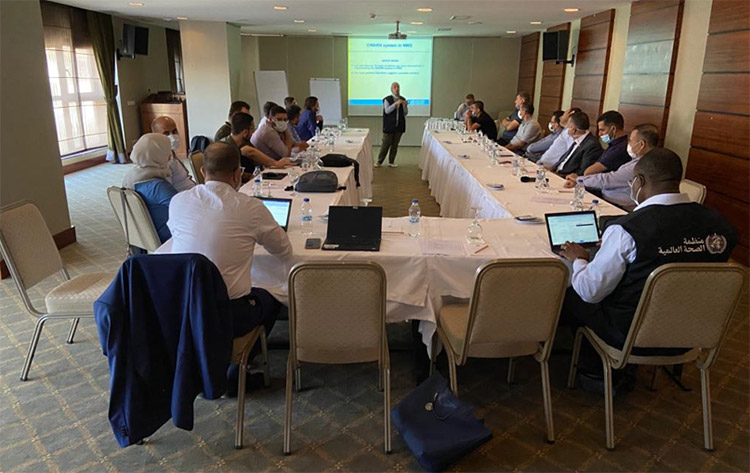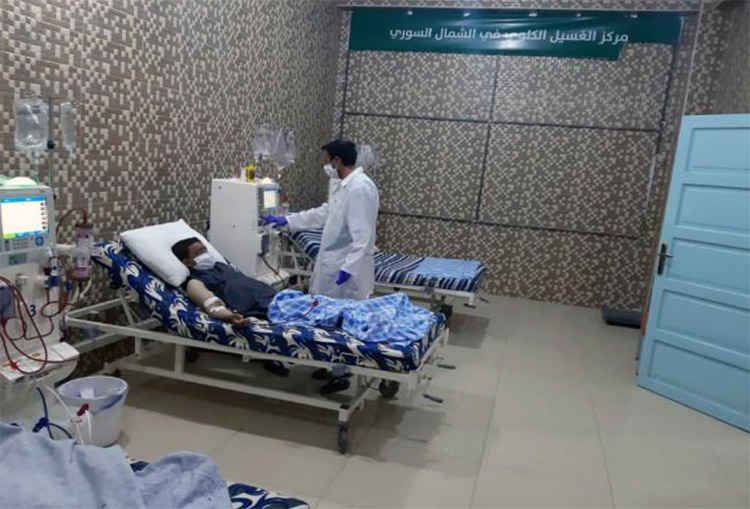Severe snowstorm in northwest Syria creates challenges for health response

26 January 2022, northwest Syria – As a snowstorm devastated the conflict zone of northwest Syria, WHO and the Health Cluster mobilized efforts to deploy rescue health services to the affected region, home to some 4.4 million people with little to no infrastructure.
On top of COVID-19, a severe snowstorm swept through northwest Syria on the night of 18 January, with temperatures plummeting as low as -15 ºC. A lack of fuel and heat, logistical difficulties, and delivery shortages – just some of the area’s daily challenges – were further exacerbated by the dangerously cold weather and the heavy snowfall. More than 59 camps for internally displaced people (IDPs) were damaged, affecting the lives of over 88 000 Syrians.
WHO was particularly concerned with the provision of immediate health services to the affected areas in the Afrin district. “We are receiving reports of extra needs for medicine and more referral services,” said Mahmoud Daher, Head of the WHO Gaziantep Field Presence, adding that reports of the closure of health facilities due to the extreme weather conditions had also been received.
WHO and the Health Cluster took instant action, coordinating with all partners in the Afrin district to come to the aid of the most affected populations. By 21 January, associates in the Health Cluster had already deployed their mobile teams and ambulances to the IDP camps and communities in Sharan, Sheikh Al Hadid, Ma’abatli, and Raju sub-districts.
WHO has recently launched an appeal for the support of the population of Syria. The current crisis confirms the urgent need for such support.
The freezing weather is especially dangerous to pregnant women, chronically-ill patients, and children – who are the most vulnerable. Following the harsh snowfall, doctors are reporting higher numbers of children with respiratory diseases.
WHO and the Health Cluster will continue to deliver extra support and services to the people of northwest Syria throughout this life-threatening season.

For more information, please contact:
Grattan Lynch
WHO Communications Officer
E-mail:
Curing Leishmaniasis in northwest Syria

15 November 2021- As WHO is dedicated to alleviating the suffering of the greatest number of people, particularly those most in need, it works with the MENTOR Initiative in northwest Syria – where IDP Camps house dense concentrations of displaced Syrians living in squalid conditions – to combat Leishmaniasis, a parasitical disease spread by the bite of infected sandflies.
Those marginalized by conflict and poverty -- and particularly the children among them - are the most vulnerable to the disease due to the overcrowding and poor sanitation characteristic of their living conditions. Come autumn, female sandflies pick up the Leishmaniasis parasite and transmit it to humans, their bite causing great damage, especially to the soft skin tissue of children.
In August 2021, a 60-year-old father brought his eight-year-old daughter to the MENTOR-supported PHC facility in Hazano, in Idlib Governorate’s Maaret Tamsrin sub-district. The girl’s face showed severe lesions with inflammation of the skin. For two months, she had been receiving herbal treatments only, and her father grew concerned with her condition which worsened by the day. If the lesions continued to grow, they would cause permanent deformity to his daughter’s face.
The lesions were diagnosed at the Hazano PHC as caused by cutaneous Leishmaniasis. Due to the severity and location of the lesions, an instant treatment of daily intramuscular Glucantime injections was commenced and prescribed to continue for 28 days. Her blood was monitored to ensure she suffered no side effects as a result of the treatment. The photographs below -- taken at initial presentation, then at 1 week, 3 weeks and 45 days from diagnosis – reveal the progression of the girl’s improvement, which occurred quickly once her treatment began.
The father brought his daughter back to the MENTOR-supported PHC facility in Hazano two weeks after the conclusion of her treatment for a follow-up appointment to confirm that the lesions were completely cured. As the photos show, this free and absolutely vital service supplied by the MENTOR Initiative saved this young child. Not only did Leishmaniasis cause lesions which would have psychologically scarred the child for life, but it is also a potentially fatal disease if left untreated. Persons suffering severe cases have perished under Leishmaniasis, either due to the disease itself or to the complications brought about by expanding cutaneous lesions.
WHO extends its sincere gratitude to its partner, the MENTOR Initiative, for the splendid work it carries out day to day in northwest Syria.
For more information, please contact:
Grattan Lynch
Communications Officer
E-mail:
WHO supporting the early warning, alert and response network in north-west Syria

21 October 2021 - Last week, an EWARN training was conducted in Gaziantep, Turkey by WHO’s Field Presence Office, with kind support by WHO EMRO. The EWARN training was supported by Technical Officers from WHO EMRO for two weeks and culminated in a 3-day event held in Gaziantep. The overall goal of the training was to aid and teach Country Level Operators (CLO) working across the border in conflict-torn northwest Syria, in responding to outbreaks. The training focused on teaching methods of EWARN surveillance and rapid response, capacity building of skills needed in the field, investigating outbreaks, support colleagues and communities to handle and react to outbreaks as well as teaching the practice of immediate response activities. By doing so, CLO would have the knowledge and know-how to react to an outbreak in the region and determine a local level responsibility for outbreaks, to reduce spread and mortalities. With this training WHO hope’s that the CLO then will spread this information on to other partners, through workshops and information, across the border in northwest Syria.
The transnational event drew on the experience of over 20 doctors and medical workers and set about addressing disease surveillance procedures and early identification of cases and clusters for rapid containment. WHO spoke about how inadequate diagnostic capacity, insufficient contact tracing, fragmented data systems, incomplete data insights for public health responders, and suboptimal governance affect the control of an outbreak. Thus, at the training, WHO reviewed the performance of EWARS and its effectiveness and usefulness in detecting, confirming, and responding to priority diseases, as well as jointly reviewing the rapid EWARN team capacity and operation and assessing its structure within the emergency operating process. By doing so, the EWARN team were able to build frontline workers' and field team members' capacities to respond effectively and efficiently to a public health alert or outbreaks.
Outbreaks covered were as follows: Acute Bloody Diarrhea, Acute Flaccid Paralysis, Acute Jaundice Syndrome, Acute Watery Diarrhea, Immunoglobulin deficiencies, Influenza Like Illness, Leishmaniasis, Measles, Meningitis, Other Acute Diarrhea, Severe Acute Respiratory Illness, Brucellosis, SARI, Impetigo, Scabies, Chickenpox, Lice, Pertussis and Influenza.
After the EWARN training concluded all partners would return to country and be able now to confidently engage with high-risk communities, and apply knowledge of their customs and cultural norms to response efforts, as well as coordinate and communicate effectively with all relevant partners and stakeholders, including focal points for the animal-human interface. WHO would like to thank all participants and to wish them all the best in the future as they in turn ensure knowledge transfer, including short- and long-term recommendations, to other key stakeholders in northwest Syria.
WHO Taskforce helps dialysis units in Northwest Syria

16 October 2021- Generated in response to the coordination needs between the multiple NGOs managing dialysis units in northwest Syria, WHO’s Dialysis Taskforce was established by the Health Cluster as an emergency project with Johns Hopkins University, Baltimore, USA, to analyze long-standing deficiencies, problems and challenges in hemodialysis units in the area, and develop and implement a series of activities to improve the quality of services for patients.
Health services in northwest Syria suffer from a lack of staff, equipment, medicine and consumables, as well as funding for operational and running costs. While maintaining access to general primary and secondary healthcare is the main objective of the humanitarian response, providing access to specialized healthcare -- especially for chronic conditions -- remains the principal challenge in a continuously changing context.
An estimated 600 patients, at least, receive hemodialysis treatment in northwest Syria. A variety of NGOs run 14 dialysis units with limited supervision from specialists. Five additional units operate in the Turkish-controlled areas to the northeast. While WHO provides kits, medicines and technical supplies to many of these NGOs at an estimated cost of $1.5 million a year, some are presented by NGO individual donors, while others still arrive through the Consolidated Appeal Process (CAP). The supplies delivered to WHO are rapidly passed to the NGOs, who store them in their warehouses in Syria.
Reports have detailed that the human and material resource capacity in dialysis units are limited, physical infrastructure is lacking, and major problems with infection control are common. Minimum defined standards for supply, process, and quality of care for dialysis units are lacking. Furthermore, the unit locations and consequent distances limit patient access.
The findings of assessments conducted by the Dialysis Taskforce on dialysis needs/services in the Idlib and Aleppo governorates in 2019 and 2020 revealed high levels of viral infections, lack of infection prevention and control (IPC) measures and minimum quality standards in practice.
The data collection process is ongoing for the quality improvement assessment. A technical team of two doctors from Johns Hopkins University arrived to Gaziantep on 16 October, 2021 to support in analyzing the data and present the results at a workshop.
Recommendations found were the need for centering on creating a series of standards appropriate to northwest Syria in the areas of patient, care, laboratory testing, record keeping, and equipment maintenance which will define the function of hemodialysis units under circumstances specific to the area. A strong emphasis in these standards will be IPC, consistent with the WHO hospital IPC standards.
WHO Gaziantep extends its gratitude to all workshop attendees, particularly to Dr Gilbert and Dr Samee of Johns Hopkins University, Baltimore, USA.
For more information, please contact:
Grattan Lynch
Communications Officer
E-mail:


